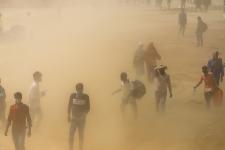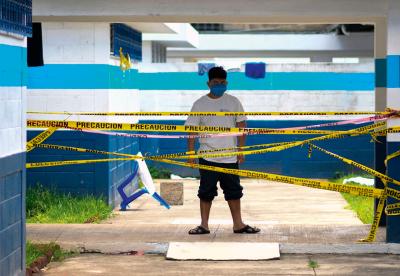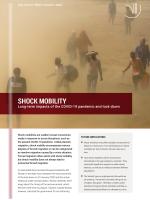Shock mobility

Shock mobilities are sudden human movements made in response to acute disruptions, such as the present COVID-19 pandemic. Unlike planned migration, shock mobility encompasses various degrees of forced migration or can be categorized as reactive migration caused by a crisis situation. Forced migration often starts with shock mobility, but shock mobility does not always lead to protracted forced migration.
■ Shock mobilities may affect broader socioeconomic relations in the future. Five manifestations of shock mobilities as ‘link moments’ provide clues as to how.
■ How shock mobilities will be received and internalized in the years ahead is uncertain. They could yield significant impacts on state-citizen relations, as well as on relations between different populations.
■ The ‘shocks’ give us a glimpse into the world we are entering. Tomorrow’s normality will grow out of today’s disruption. Therefore, a better understanding of ongoing shock mobilities will help us analyse potential problems for decades to come.
An estimated three hundred thousand residents left Wuhan in the eight hours between the announcement of the lock-down on 23 January 2020 and the actual halting of public transportation. Wuhan residents were angry about the timing of the announcement, which left them little time to prepare. Citizens outside Wuhan, however, criticized the government for not enforcing the lock-down immediately, arguing that panic flights could potentially spread the virus even further. When the global epicentre of the virus moved to Europe in March, thousands of Milan residents fled the city to avoid the cordon sanitaire. Authorities called the southward exodus an act of madness and urged people to go back.
After the Indian government announced a nationwide lockdown on 24 March 2020, seven and a half million internal migrants flocked home in desperation. Many walked for days due to the lack of public transport. Fear of the virus and job losses in cities have reversed decades-long trends of rural-urban migration elsewhere too. In Peru, Lima bus terminals were crowded with internal migrants wanting to return to their rural families. Such shock mobilities raised concerns about the potential spread of the virus to rural areas.
In the United States, students from Asia, particularly China, rushed to leave the new hotspots for home. Air-travel prices were hiked ten-fold overnight. Many students bought multiple tickets at a time, anticipating that some flights would be cancelled, while others were stranded in transit.
Shock mobility is not a new type of mobility. Unlike seasonal, circular or other forms of migration, it cannot be defined by the actor, the cause or a particular pattern of behaviour. By definition, shock mobility defies stabilization.
Border closures, increased enforcement and decreased availability or access to humanitarian assistance have placed migrants, asylum-seekers and refugees in limbo. Mobility restrictions related to the COVID-19 response have led to the loss of both sources of income and places of shelter. At least 68,000 Venezuelans returned to Venezuela between mid-March and late May, while irregular Moroccan and Algerian migrants in Spain and Italy have used reverse smuggling infrastructure to overcome travel bans on their return.
Short-lived shocks with long after-lives
Shock mobility is not a new type of mobility. Unlike seasonal, circular or other forms of migration, it cannot be defined by the actor, the cause or a particular pattern of behaviour. By definition, shock mobility defies stabilization.
The dynamics are often overlooked, an oversight that has gained immense relevance in the present moment. A new focus on shock mobilities could potentially unpack the nature of im/mobilities and explore their consequences beyond refugee migrations.
Shock mobilities are testimonies not only to how people experience turmoil, but also to their transformative potential. We may therefore see contours of shocks that are transformative, hold back changes or push society in a direction that often is fixed by some at the cost of others.
The patterns are complex: they save lives but can also inflict harm. Do such movements necessarily undermine government measures of disease control, wake up the public to the severity of the pandemic, or become a convenient excuse for increasing mobility control further? Because we know too little about the patterns, duration, density, demographic composition and temporal dynamics of shock mobilities, we cannot answer these questions.
Shock mobilities are testimonies not only to how people experience turmoil, but also to their transformative potential. We may therefore see contours of shocks that are transformative, hold back changes or push society in a direction that often is fixed by some at the cost of others.
Discussions of shock mobilities — how they are conditioned by existing conditions, how they end and give way to apparent normality, and how social relations are altered in the process — present us with methodological challenges as well as analytical ones. As dramatic events have come to define our lives, mobility must be conceptualized in new ways.
A link between movements
Shock mobility can be conceptualized as a link between various movements, or a moment when different mobilities and immobilities become intensively entangled with each other. These interrelated im/mobilities constitute ‘mobility assemblages’.

Consider the journey of a migrant family that walked across India at the onset of the pandemic or the Venezuelan return refugees mentioned earlier. They were not ‘shocked’ into mobility: they were mobile in the first place. To survive, they were constantly on the move as street vendors, delivery workers, domestic servants, sex workers, rickshaw pullers, bus drivers, construction workers or garbage pickers. The moment they stopped moving was the moment they lost their jobs and had no money to pay their rent or buy food. They were pushed into shock mobilities because the pandemic and lockdown disrupted their rhythms of mobility. Thus, migrants’ shock mobilities must be understood in relation to their other migratory practices, other actors’ mobility and immobility, and mobility politics.
Following that logic, we observe that shock mobility as a ‘link moment’ in mobility assemblages has at least five specific forms:
1. Reaction mobility is a direct response to threats. Research suggests that running away is the usual reaction to high-mortality epidemics across countries. The imposition of a cordon sanitaire seems to have induced intensified and larger-scale flights of population. Information from different parts of the world during the COVID-19 pandemic suggests that mistrust in the authorities may be more important than perceptions about health risks in causing reaction mobilities.
2. Reaction immobility. Since shock mobility is about sudden mutations in movement rather than mobilit per se, immobilization may be more dramatic than movement. Observations of the COVID-19 pandemic point to two populations that have been most liable to reaction immobility: the urban middle classes, who isolated themselves because of sensitivity to health risks and could afford to stay at home; and rural communities, which, due to poor health-care facilities and physical isolation, protect themselves by fencing off their communities.
3. Survival mobility is necessary for those who lost livelihoods due to mobility restrictions. Going home is a typical means of survival mobility, regardless of how inhospitable or conflict-ridden that home may be, as the return of Venezuelans and other refugees shows.
4. Limbo mobility, or movements without destinations or even stoppages, became widespread during the pandemic. People in shock mobilities may be ill-prepared in terms of where they want to go and how, and they may be turned away by communities along the way due to the latter’s fears of them. This has created a sizable ‘homeless’ population that cannot leave a city for ‘home’ or check into hotels but instead have to move between parks, railway stations and hospitals in order to access food, health care and shelter for the night. In many places, the central challenge quickly shifted from stopping mobility to moving migrants ‘back home’.
5. Substitution mobility is movement carried out by some groups on behalf of others. It is crucial during lockdowns and can be organized by governments. Substitution mobilities are likely to further the casualization of labour (especially for delivery workers) and the securitization of mobilities, as more and more movement falls under constant monitoring by either the state or platform companies. This is the case even though these mobilities are indispensable in carrying us through the shocks and providing us with some sense of normality. In turn, they can be quickly normalized.
Biao Xiang, Professor of Social Anthropology, University of Oxford, and Director of the Max Plank Institute for Social Anthropology in Halle (biao.xiang@anthro.ox.ac.uk)
Ninna Nyberg Sørensen, Head of the Migration & Global Order Department at DIIS (nns@diis.dk)
DIIS Experts


